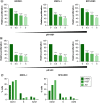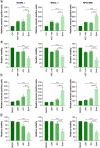Epigenetic targeting of Waldenström macroglobulinemia cells with BET inhibitors synergizes with BCL2 or histone deacetylase inhibition
- PMID: 33356554
- PMCID: PMC8656319
- DOI: 10.2217/epi-2020-0189
Epigenetic targeting of Waldenström macroglobulinemia cells with BET inhibitors synergizes with BCL2 or histone deacetylase inhibition
Erratum in
-
Corrigendum.Epigenomics. 2021 Jun;13(11):909-911. doi: 10.2217/epi-2020-0189c1. Epub 2021 Apr 26. Epigenomics. 2021. PMID: 33899492 Free PMC article. No abstract available.
Abstract
Aim: Waldenström macroglobulinemia (WM) is a low-grade B-cell lymphoma characterized by overproduction of monoclonal IgM. To date, there are no therapies that provide a cure for WM patients, and therefore, it is important to explore new therapies. Little is known about the efficiency of epigenetic targeting in WM. Materials & methods: WM cells were treated with BET inhibitors (JQ1 and I-BET-762) and venetoclax, panobinostat or ibrutinib. Results: BET inhibition reduces growth of WM cells, with little effect on survival. This finding was enhanced by combination therapy, with panobinostat (LBH589) showing the highest synergy. Conclusion: Our studies identify BET inhibitors as effective therapy for WM, and these inhibitors can be enhanced in combination with BCL2 or histone deacetylase inhibition.
Keywords: BET inhibitors; Waldenström macroglobulinemia; epigenetics; panobinostat; venetoclax.
Conflict of interest statement
This research was supported by an NIH COBRE Center of Integrated Biomedical and Bioengineering Research (CIBBR, P20 GM113131) through an Institutional Development Award (IDeA) from the National Institute of General Medical Sciences. This work was supported in part by a grant from the International Waldenström Macroglobulinemia Foundation and the Leukemia & Lymphoma Society (IWMF-LLS). The authors have no other relevant affiliations or financial involvement with any organization or entity with a financial interest in or financial conflict with the subject matter or materials discussed in the manuscript apart from those disclosed.
No writing assistance was utilized in the production of this manuscript.
Figures







Similar articles
-
Co-Binding of JQ1 and Venetoclax Exhibited Synergetic Inhibitory Effect for Cancer Therapy; Potential Line of Treatment for the Waldenström Macroglobulinemia Lymphoma.Chem Biodivers. 2022 Jul;19(7):e202100845. doi: 10.1002/cbdv.202100845. Epub 2022 Jun 8. Chem Biodivers. 2022. PMID: 35610180
-
Waldenstrom macroglobulinemia cells devoid of BTKC481S or CXCR4WHIM-like mutations acquire resistance to ibrutinib through upregulation of Bcl-2 and AKT resulting in vulnerability towards venetoclax or MK2206 treatment.Blood Cancer J. 2017 May 26;7(5):e565. doi: 10.1038/bcj.2017.40. Blood Cancer J. 2017. PMID: 28548645 Free PMC article.
-
Venetoclax in Previously Treated Waldenström Macroglobulinemia.J Clin Oncol. 2022 Jan 1;40(1):63-71. doi: 10.1200/JCO.21.01194. Epub 2021 Nov 18. J Clin Oncol. 2022. PMID: 34793256 Free PMC article. Clinical Trial.
-
Novel approaches to targeting MYD88 in Waldenström macroglobulinemia.Expert Rev Hematol. 2017 Aug;10(8):739-744. doi: 10.1080/17474086.2017.1343661. Epub 2017 Jun 28. Expert Rev Hematol. 2017. PMID: 28617062 Review.
-
What is new in the treatment of Waldenstrom macroglobulinemia?Leukemia. 2019 Nov;33(11):2555-2562. doi: 10.1038/s41375-019-0592-8. Epub 2019 Oct 7. Leukemia. 2019. PMID: 31591468 Review.
Cited by
-
A novel mechanism of regulation of the oncogenic transcription factor GLI3 by toll-like receptor signaling.Oncotarget. 2022 Aug 3;13:944-959. doi: 10.18632/oncotarget.28261. eCollection 2022. Oncotarget. 2022. PMID: 35937499 Free PMC article.
-
Nucleic Acid Biomarkers in Waldenström Macroglobulinemia and IgM-MGUS: Current Insights and Clinical Relevance.Diagnostics (Basel). 2022 Apr 12;12(4):969. doi: 10.3390/diagnostics12040969. Diagnostics (Basel). 2022. PMID: 35454017 Free PMC article. Review.
-
Targeting BCL2 in Waldenström macroglobulinemia: from biology to treatment management.Front Oncol. 2025 Apr 22;15:1564869. doi: 10.3389/fonc.2025.1564869. eCollection 2025. Front Oncol. 2025. PMID: 40330831 Free PMC article. Review.
-
Intracellular and Extracellular Antifreeze Protein Significantly Improves Mammalian Cell Cryopreservation.Biomolecules. 2022 May 5;12(5):669. doi: 10.3390/biom12050669. Biomolecules. 2022. PMID: 35625597 Free PMC article.
-
Multi-catalytic Sites Inhibition of Bcl2 Induces Expanding of Hydrophobic Groove: A New Avenue Towards Waldenström Macroglobulinemia Therapy.Protein J. 2022 Apr;41(2):201-215. doi: 10.1007/s10930-022-10046-9. Epub 2022 Mar 2. Protein J. 2022. PMID: 35237907
References
-
- Kapoor P, Paludo J, Vallumsetla N, Greipp PR. Waldenström macroglobulinemia: what a hematologist needs to know. Blood Rev. 29(5), 301–319 (2015). - PubMed
-
•• Discusses aspects of Waldenström macroglobulinemia (WM) disease.
-
- Treon SP, Gustine J, Meid K et al. Ibrutinib monotherapy in symptomatic, treatment-naïve patients with Waldenström macroglobulinemia. J. Clin. Oncol. 36(27), 2755–2761 (2018). - PubMed
-
• Discusses the role of ibrutinib in WM.
-
- Sun JY, Xu L, Tseng H et al. Histone deacetylase inhibitors demonstrate significant preclinical activity as single agents, and in combination with bortezomib in Waldenström’s macroglobulinemia. Clin. Lymphoma Myeloma Leuk. 11, 152-156 (2011). - PubMed
-
• Efficacy of epigenetic targeting in WM using histone deacetylase inhibitors.
Publication types
MeSH terms
Substances
Grants and funding
LinkOut - more resources
Full Text Sources
Other Literature Sources
